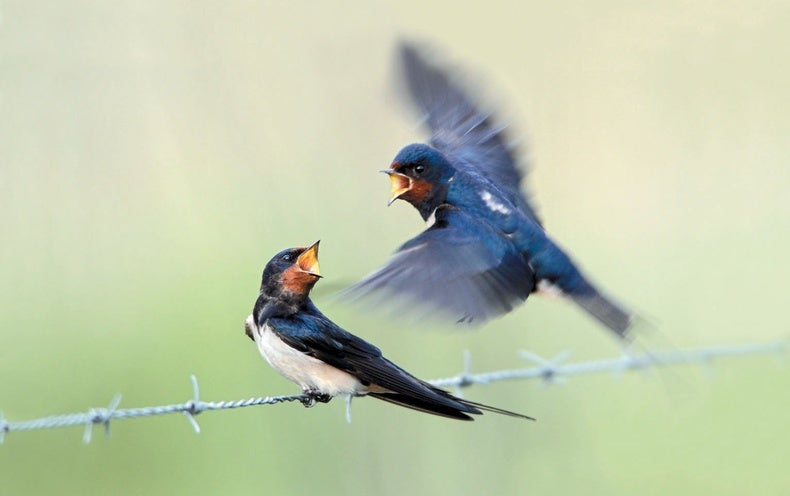Female birds sing. That is one conclusion of our 2020 study on one of the most abundant, widespread, well-studied bird species in the world: the barn swallow. Despite the well over 1,000 scientific publications about this species, female barn swallow song had never previously been the focus of a research article.
Why does it matter that female song has been ignored in this bird that breeds across most of North America? It highlights a long-standing scientific bias and helps us think about why that bias persists.
Since the beginning of modern birdsong research, the field has focused on the conspicuous songs of male songbirds. Conventional evolutionary theory assumes that across the animal kingdom, males compete for access to females, leading male animals to evolve exaggerated traits (like antlers) that help them fight off other males, as well as features (like the fabulous feathers of peacocks) that attract females. Birdsongs can function in both these contexts, and although males may have more elaborate songs than females, this is far from universal. In fact, females sing in at least 64 percent of songbird species, and their songs can serve the same functions as male songs.
Yet many researchers still assume that “the male bird sings, and the female chooses,” with field studies overwhelmingly focused on the more abundant male signals. The most frequent song, however, might not always be the most important, just as a debate can be settled by who had the last word rather than who spoke the most. Our study suggests that the evolution of female barn swallow songs is more important than the evolution of male songs for explaining why the two sexes sound different.
A second reason for the neglect of female birdsong stems from geographic bias. Any ornithologist or serious birder working in the tropics could tell you that females do sing, sometimes as frequently as males. But early researchers tended to study species near their universities in the Northern Hemisphere. In a large proportion of North American birds, females have lost or reduced their songs, which may represent evolutionary adaptations to conserve energy for migration or to focus on breeding during a short season.
A final reason for female birdsong being understudied could be gender. Men have dominated birdsong research from its inception. As more women enter the field, however, they are spurring an exuberant surge in the study of female song. Women are much more likely than men to be first authors on papers on female birdsong. The historical lack of diverse participation in science may have contributed to researchers forming self-reinforcing assumptions that impeded a full understanding of the world around us.
To combat such biases in the scientific canon, we need to make science more accessible to all. For example, if we can make people aware that female birds sing, we will enhance their experience of nature and improve their ability to observe it. In many species, including barn swallows, males and females look similar from a distance but can be distinguished by ear. Female barn swallows primarily sing just before they begin breeding—knowing that can help observers track the timing of barn swallow nesting, for example. Initiatives such as xeno-canto and eBird collect millions of public observations and audio recordings of birds every year. People who understand the latest science will create better global data sets, which, in turn, will generate better science.
Nonscientists make better observers because they lack preconceived notions. One of us (Benedict) often talks to public groups and finds that birders (“experts”) tend to assume female birds don’t sing, whereas nonbirders tend to assume female birds might sing. Lessons about authentic science are ideal for engaging children, in particular, who have yet to absorb existing biases. One of us (Wilkins) adapted our female songbird research into a free interdisciplinary lesson for grades 5–12 (available at galacticpolymath.com). Wilkins once told a fifth grade math class they were among the first people in the world to explore a data set from a study on how bird vocal pitch decreases with body size, and they spontaneously broke into applause.
Female birds sing! We need to declare that truth so emphatically because it reflects the constant adjustments to the scientific consensus as new facts become available and new voices are added to the conversation. We welcome a future where research, communication and education combine to deepen our connections to one another and the natural world.
































